您好,登錄后才能下訂單哦!
您好,登錄后才能下訂單哦!
這篇文章將為大家詳細講解有關如何進行實驗室站遷移Serverless,文章內容質量較高,因此小編分享給大家做個參考,希望大家閱讀完這篇文章后對相關知識有一定的了解。
2 月份,TencentServerless 舉辦了系列在線課堂分享,講解了 Serverless 概念、架構、最佳實踐以及如何開發一個 component 等技術知識。
因為對 Serverless 非常感興趣,每次都參加了直播學習并提交了課堂作業,一路下來感覺還不錯,因此決定把自己的實驗室站遷移到 Serverless 試試看。
不得不感嘆互聯網時代科技的進步,之前我的實驗室站采用的是傳統方法發布網站的環境部署,雖然現在熟悉了操作并不覺得很麻煩,但是對于從來沒接觸過這塊的人來說就比較難懂了。
而現在有了 Serverless,就可以完全無視上面的操作步驟了,這里引用官網的兩段話:
Serverless Framework 可以幫您以更少的成本和開銷, 快速構建 Serverless 應用。它能夠完美支持無服務器應用的開發,部署,測試,監控等環節。Serverless 是面向未來的運維方式。
Serverless 建立在下一代公共云服務之上,該服務僅在使用時自動擴容和收費。當規模,所用容量和成本管理實現自動化時,可節省 99% 的成本管理。
無服務器架構是全新的,因此我們需要改變先前對老架構和工作流的看法。Serverless Framework 的目標是以一種簡單,強大而優雅的使用體驗為開發者、團隊提供開發和運行 serverless 應用程序所需的所有工具。
這種方式非常方便,本人現在倒是覺得對于個人開發者來說,如果想構建輕量應用的話,用 Serverless 應該會節省非常多的時間。當然 Serverless 對比傳統型應用還是有區別的,目前它并不能完美支持,舉一個例子:Flask CLI 就不支持,不過相信隨著 Serverless 技術的發展,Serverless 的支持將更加全面。
對于企業開發者來說也是同理的,想快速上線一套網站的話,部署在一個服務器上倒是好說,可是當訪問量上升之后,需要擴容的時候就比較麻煩了,這時候你得在多個服務器上部署并且配置負載均衡等等。
對我個人來說,我覺得 Serverless 最大的優點在于運維部署方面,通過 Serverless 部署,還是非常方便的。
Serverless Framework 是基于 Node.js 的開源 CLI,注:需 Node 8+ 全局安裝:
npm install serverless -g
這里沒有使用 cnpm 的原因是因為網絡還算 ok 沒有特別耗時,另外忘記了之前在哪里看到過 cnpm 不會更新 package-lock.json,因此也就沒有再去用第三方源。之后更新的話就
npm install serverless -g
官網的快速開始教程之后快速部署了個 demo,即:
serverless create -t tencent-nodejs
命令里的 tencent-nodejs 是眾多組件中的一個,組件列表:https://github.com/serverless/components
因為本人對 Flask 還算熟悉,所以干脆把部署這個 Component 當成 Hello World 好了。其中官網簡介里寫道:任何支持 WSGI(Web Server Gateway Interface)的 Python 服務端框架都可以通過該組件進行部署,例如 Falcon 框架等。
1) 創建新項目
通過 sls 直接根據模板創建服務,Serverless github 上有很多模板 比如:https://github.com/serverless/components/tree/master/templates/tencent-flask
serverless create --template-url https://github.com/serverless/components/tree/master/templates/tencent-flask
源碼如下:
# -*- coding: utf8 -*-
import json
from flask import Flask, jsonify, request
app = Flask(__name__)
@app.route("/")
def index():
return "Hello Flash"
@app.route('/user', methods = ['POST'])
def addUser():
# we must get request body from clound function event;
event = request.environ['event']
user = json.loads(event['body'])
return jsonify(data=user)
@app.route("/user", methods = ['GET'])
def listUser():
users = [{'name': 'test1'}, {'name': 'test2'}]
return jsonify(data=users)
@app.route("/user/<id>", methods = ['GET'])
def getUser(id):
return jsonify(data={'name': 'test1'})不基于模板
在 Pycharm 創建一個新的 Flask 項目:LAB_Serverless 以區別之前的 LAB
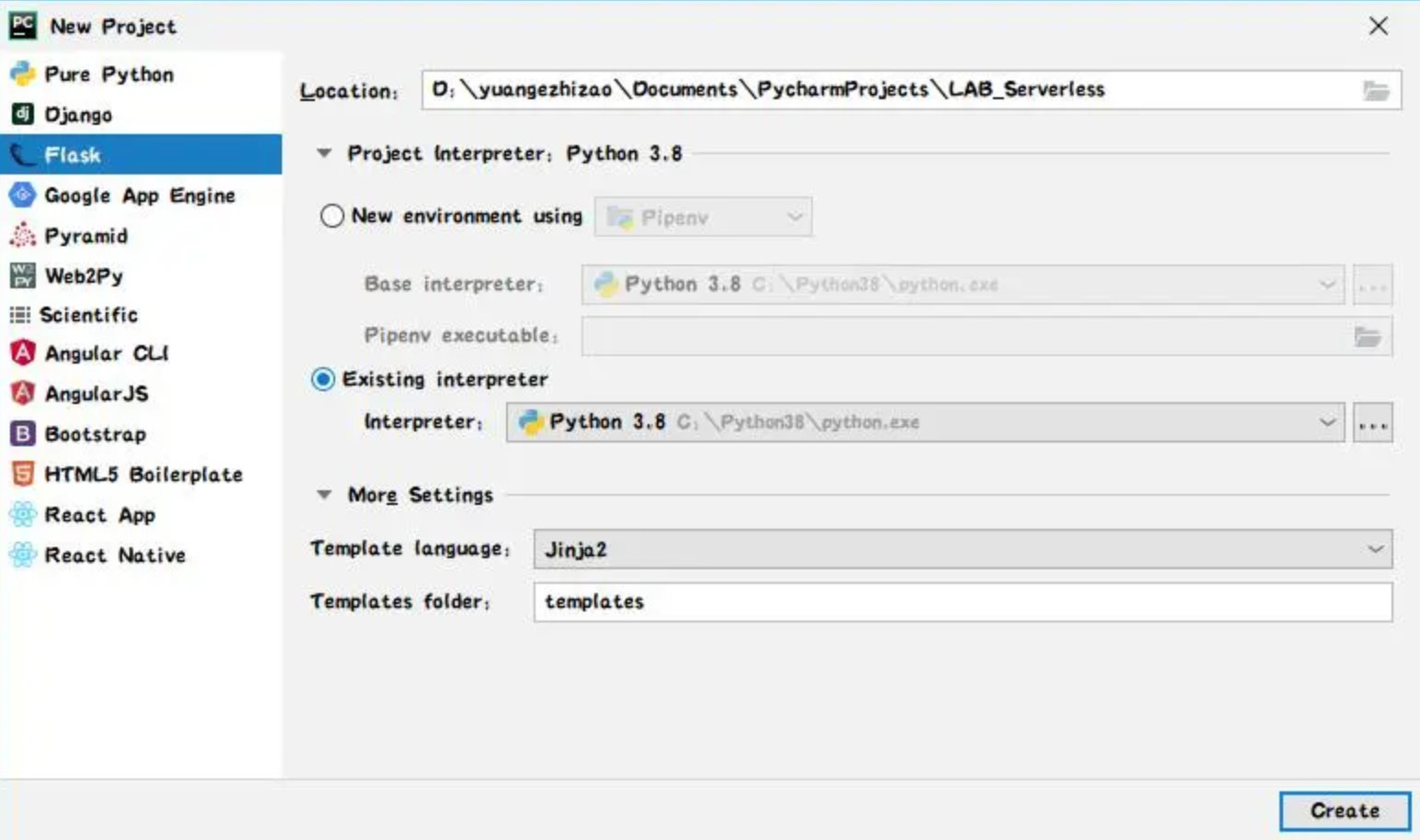
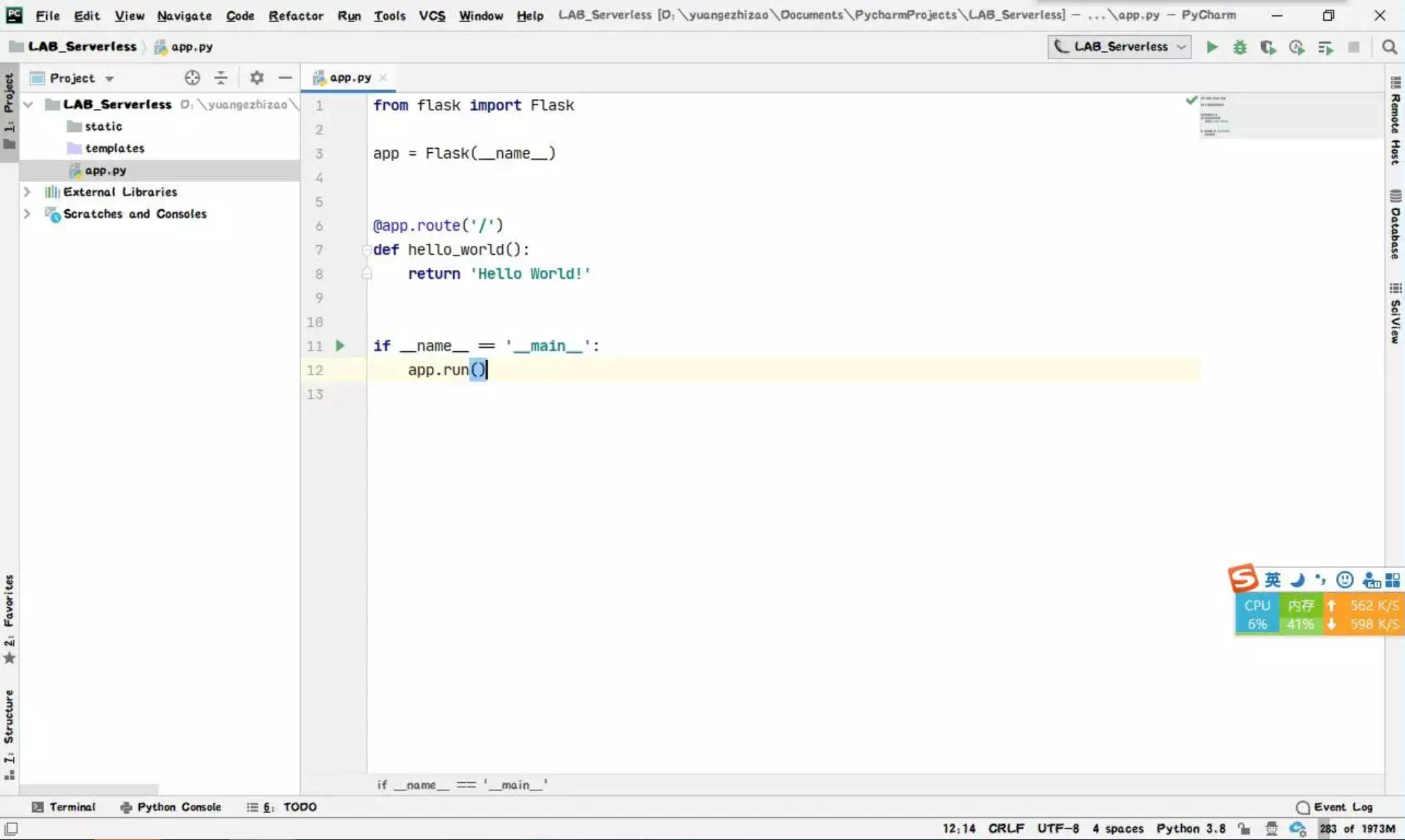
源碼如下:
from flask import Flask
app = Flask(__name__)
@app.route('/')
def hello_world():
return 'Hello World!'
if __name__ == '__main__':
app.run()2) 配置Serverless
創建serverless.yml,這里更改了幾處配置
MyComponent: component: '@serverless/tencent-flask' inputs: region: ap-beijing functionName: LAB_Serverless code: ./ functionConf: timeout: 10 memorySize: 128 environment: variables: TEST: value Version: 2020-2-23_21:01:44 vpcConfig: subnetId: '' vpcId: '' apigatewayConf: protocol: https environment: test
創建.env,寫入密匙(因為懶得每次部署都得拿起手機掃一掃授權(^_?)☆
TENCENT_SECRET_ID=<rm> TENCENT_SECRET_KEY=<rm>
3) 部署
serverless 的縮寫是 sls,因此也可以用 sls 簡化命令。但是這里報錯了……報錯的原因是requirements文件夾不存在。
查看終端
Microsoft Windows [版本10.0.17763.1039] (c) 2018 Microsoft Corporation。保留所有權利。 D:\yuangezhizao\Documents\PycharmProjects\LAB_Serverless>sls --debug DEBUG─Resolving the template's static variables. DEBUG─Collecting components from the template. DEBUG─Downloading any NPM components found in the template. DEBUG─Analyzing the template's components dependencies. DEBUG─Creating the template's components graph. DEBUG─Syncing template state. DEBUG─Executing the template's components graph. DEBUG─Compressing function LAB_Serverless file to D:\yuangezhizao\Documents\PycharmProjects\LAB_Serverless\.serverless/LAB_Serverless.zip. (node:22500) UnhandledPromiseRejectionWarning: Error: ENOENT: no such file or directory, stat 'D:\yuangezhizao\Documents\PycharmProjects\LAB_Serverless\. serverless\requirements'eploying at Object.statSync (fs.js:946:3) at Object.statSync (C:\Users\yuangezhizao\AppData\Roaming\npm\node_modules\serverless\node_modules\_graceful-fs@4.2.3@graceful-fs\polyfills.js:308:16 ) at WriteStream.<anonymous> (C:\Users\yuangezhizao\.serverless\components\registry\npm\@serverless\tencent-flask@0.2.0\node_modules\@serverless\tencen t-flask\node_modules\@serverless\tencent-scf\library\utils.js:124:20) at WriteStream.emit (events.js:304:20) at C:\Users\yuangezhizao\.serverless\components\registry\npm\@serverless\tencent-flask@0.2.0\node_modules\@serverless\tencent-flask\node_modules\grac eful-fs\graceful-fs.js:298:14 at C:\Users\yuangezhizao\.serverless\components\registry\npm\@serverless\tencent-flask@0.2.0\node_modules\@serverless\tencent-flask\node_modules\grac eful-fs\graceful-fs.js:325:16 at C:\Users\yuangezhizao\AppData\Roaming\npm\node_modules\serverless\node_modules\_graceful-fs@4.2.3@graceful-fs\graceful-fs.js:325:16 at FSReqCallback.oncomplete (fs.js:152:23) (node:22500) UnhandledPromiseRejectionWarning: Unhandled promise rejection. This error originated either by throwing inside of an async function without a catch block, or by rejecting a promise which was not handled with .catch(). (rejection id: 1) (node:22500) [DEP0018] DeprecationWarning: Unhandled promise rejections are deprecated. In the future, promise rejections that are not handled will termi nate the Node.js process with a non-zero exit code. 194s?MyComponent?canceled 終止批處理操作嗎(Y/N)? Y D:\yuangezhizao\Documents\PycharmProjects\LAB_Serverless>
然后去 .serverless 文件下的 Template.MyComponent.pyRequirements.json 文件中看到了requirements.txt。這里其實是故意操作的(特意沒添加requirements.txt),說明 requirements.txt 必須存在!
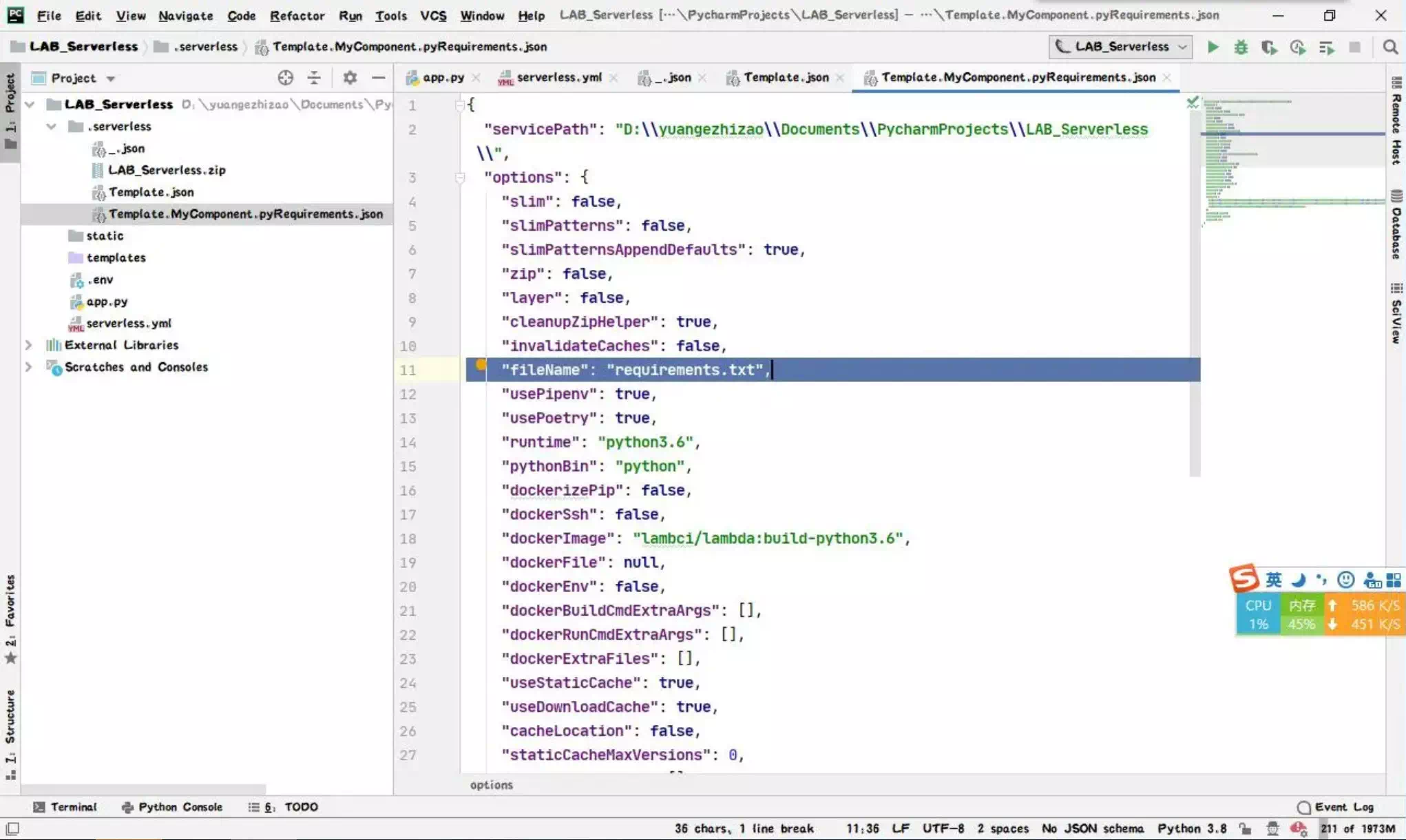
因此,去創建文件內容為 Flask 的 requirements.txt
D:\yuangezhizao\Documents\PycharmProjects\LAB_Serverless>sls --debug DEBUG─Resolving the template's static variables. DEBUG─Collecting components from the template. DEBUG─Downloading any NPM components found in the template. DEBUG─Analyzing the template's components dependencies. DEBUG─Creating the template's components graph. DEBUG─Syncing template state. DEBUG─Executing the template's components graph. DEBUG─Generated requirements from D:\yuangezhizao\Documents\PycharmProjects\LAB_Serverless\requirements.txt in D:\yuangezhizao\Documents\PycharmProje cts\LAB_Serverless\.serverless\requirements.txt... DEBUG─Installing requirements from C:\Users\yuangezhizao\AppData\Local\Yugasun\serverless-python-requirements\Cache\2a1a661c4e3e6faadab5d001bc10cc3ac ccf648921aad7c279d94f138eaaf833_slspyc\requirements.txt ... DEBUG─Using download cache directory C:\Users\yuangezhizao\AppData\Local\Yugasun\serverless-python-requirements\Cache\downloadCacheslspyc DEBUG─Running ... DEBUG─Compressing function LAB_Serverless file to D:\yuangezhizao\Documents\PycharmProjects\LAB_Serverless\.serverless/LAB_Serverless.zip. DEBUG─Compressed function LAB_Serverless file successful DEBUG─Uploading service package to cos[sls-cloudfunction-ap-beijing-code]. sls-cloudfunction-default-LAB_Serverless-1582464464.zip DEBUG─Uploaded package successful D:\yuangezhizao\Documents\PycharmProjects\LAB_Serverless\.serverless/LAB_Serverless.zip DEBUG─Creating function LAB_Serverless DEBUG─Created function LAB_Serverless successful DEBUG─Setting tags for function LAB_Serverless DEBUG─Creating trigger for function LAB_Serverless DEBUG─Deployed function LAB_Serverless successful DEBUG─Starting API-Gateway deployment with name MyComponent.TencentApiGateway in the ap-beijing region DEBUG─Service with ID service-0ok85tqh created. DEBUG─API with id api-ivk6tk0y created. DEBUG─Deploying service with id service-0ok85tqh. DEBUG─Deployment successful for the api named MyComponent.TencentApiGateway in the ap-beijing region. MyComponent: region: ap-beijing functionName: LAB_Serverless apiGatewayServiceId: service-0ok85tqh url: http://service-0ok85tqh-1251901037.bj.apigw.tencentcs.com/test/ 44s?MyComponent?done D:\yuangezhizao\Documents\PycharmProjects\LAB_Serverless>
趁機看下部署成功之后的 .serverless 文件夾:
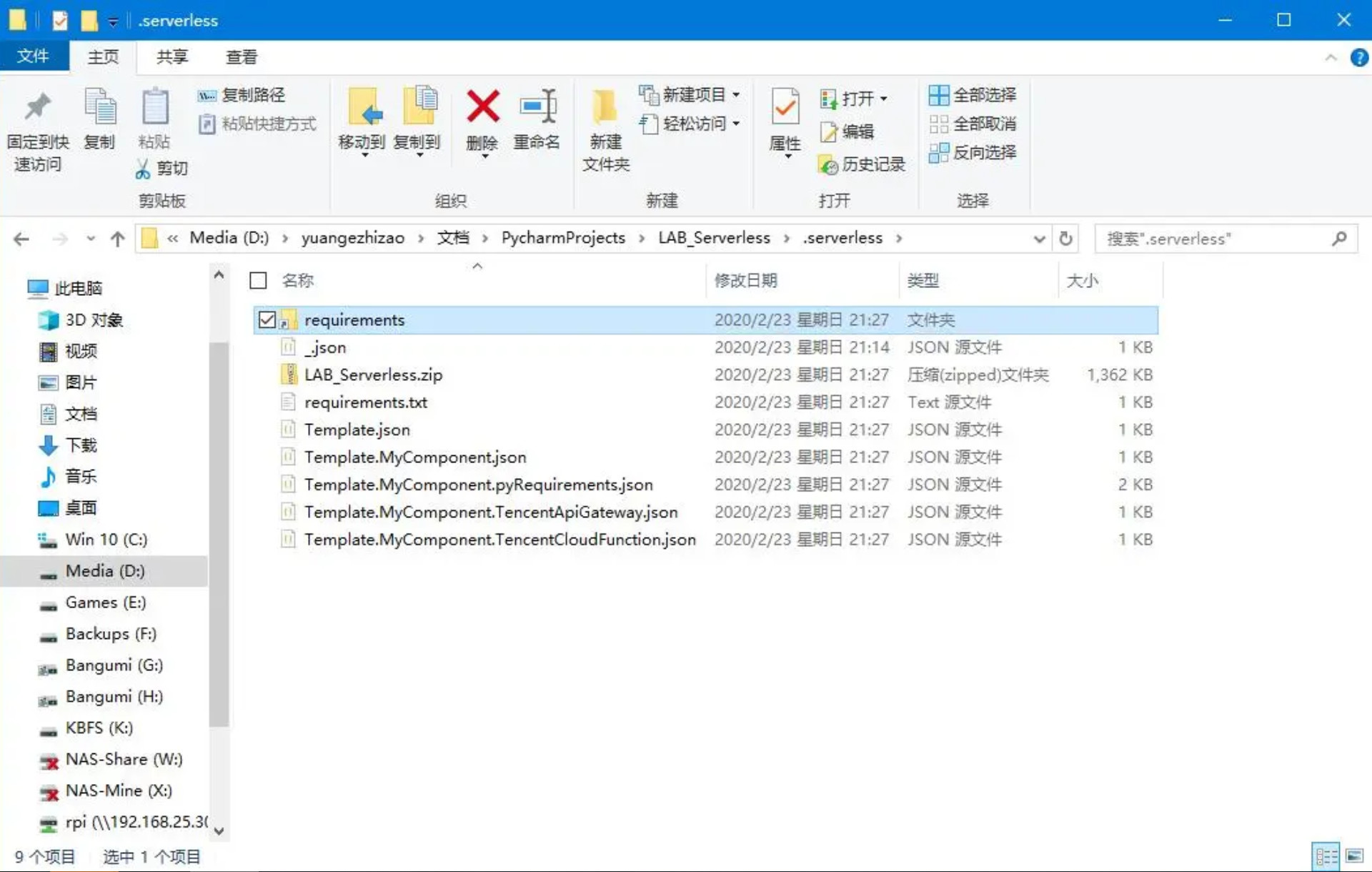
這里 Template.MyComponent.TencentCloudFunction.json 即云函數
{
"deployed": {
"Name": "LAB_Serverless",
"Runtime": "Python3.6",
"Handler": "api_service.handler",
"MemorySize": 128,
"Timeout": 10,
"Region": "ap-beijing",
"Description": "This is a template function"
}
}第三方包全在這里:
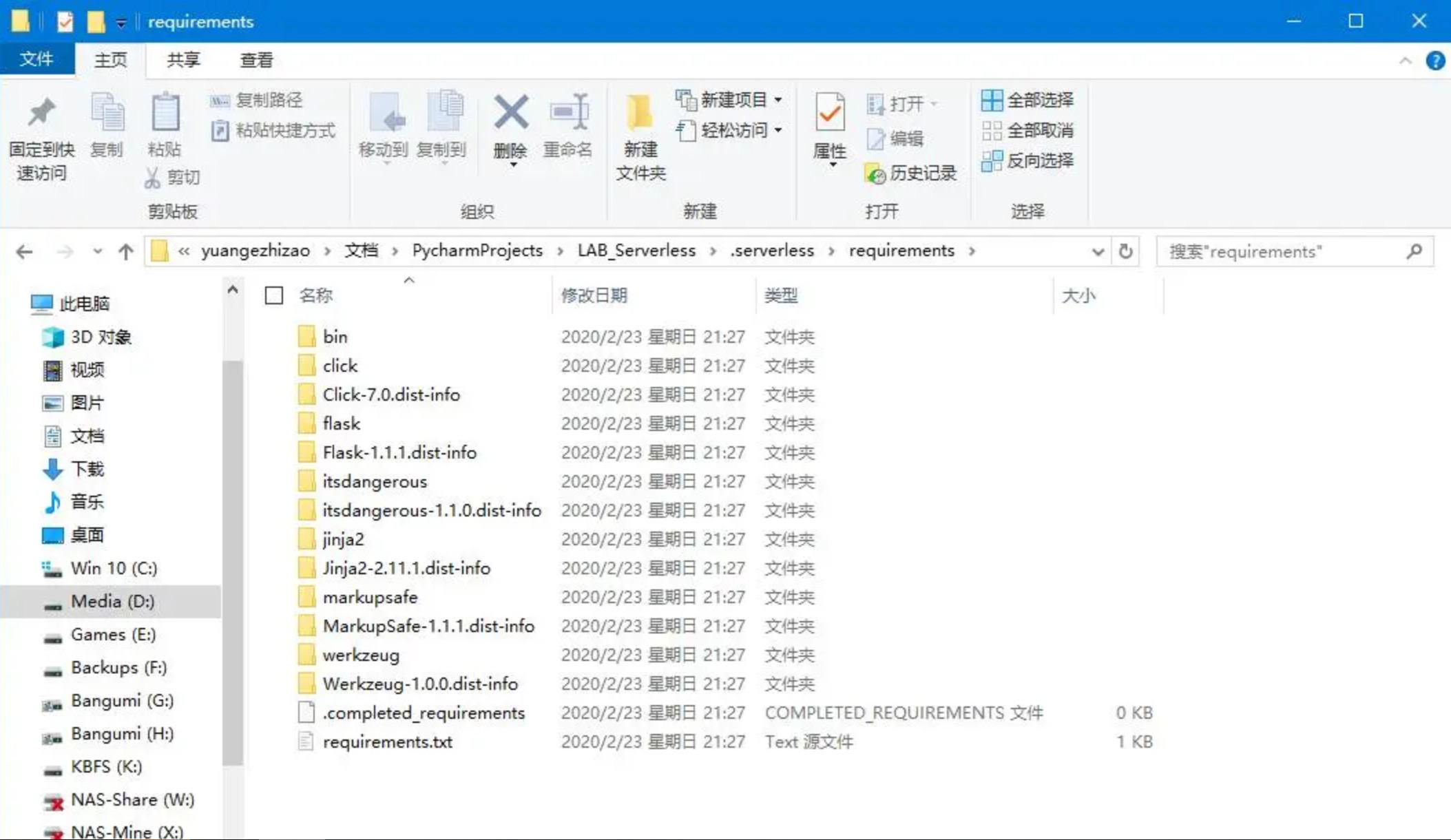
Template.MyComponent.TencentApiGateway.json 即 API 網關
{
"protocols": [
"http"
],
"subDomain": "service-0ok85tqh-1251901037.bj.apigw.tencentcs.com",
"environment": "test",
"region": "ap-beijing",
"service": {
"value": "service-0ok85tqh",
"created": true
},
"apis": [
{
"path": "/",
"method": "ANY",
"apiId": {
"value": "api-ivk6tk0y",
"created": true
}
}
]
}也就是說CLI自動幫我們創建SCF并將運行環境一并上傳,再創建API 網關配置到SCF的觸發器上。
apigatewayConf: protocol: https environment: test
到這里demo就搞定了,已經可以正常訪問了 。
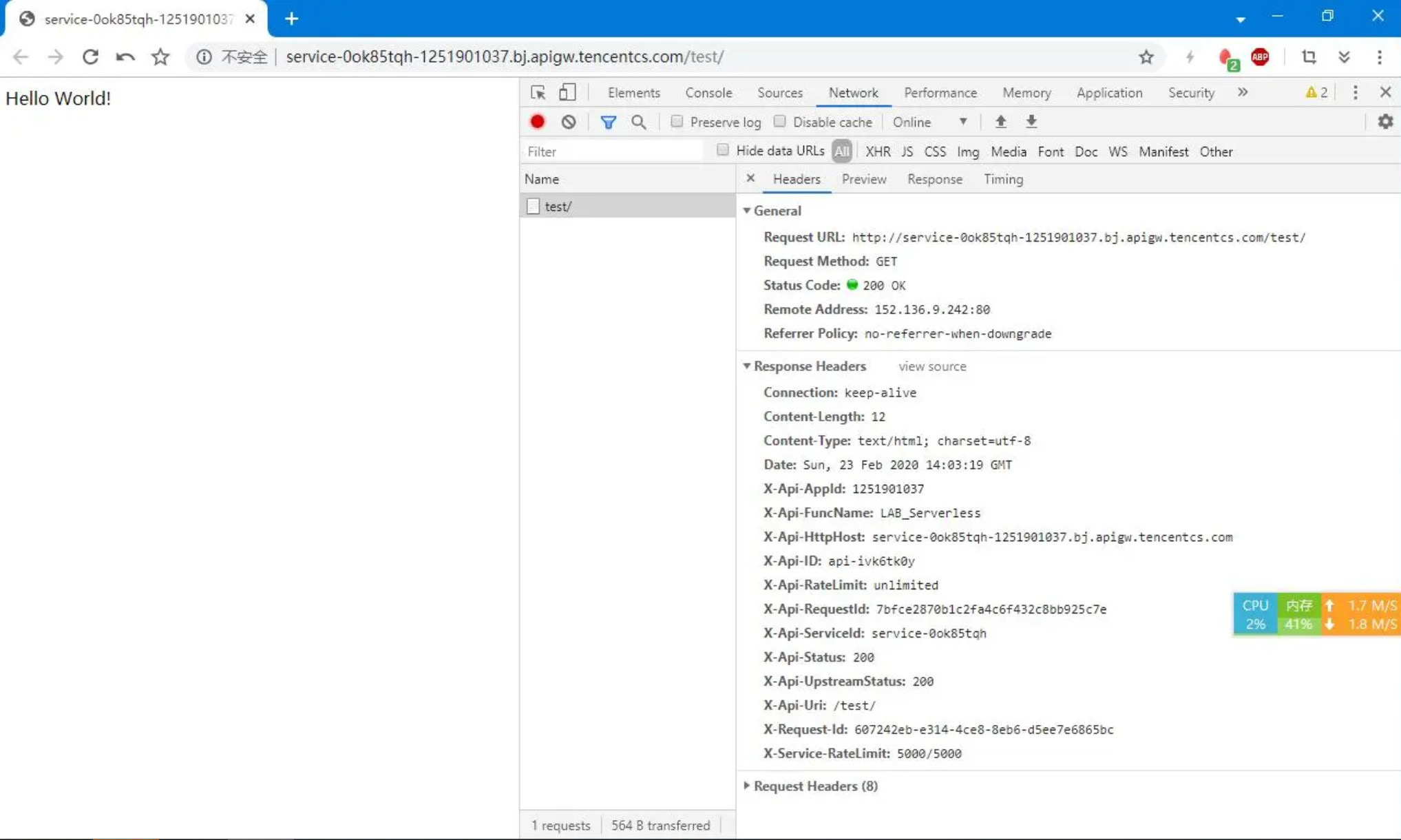
去云函數看實際運行環境,發現把.idea文件夾也給上傳了 另外,多了如下倆本地沒有的文件:
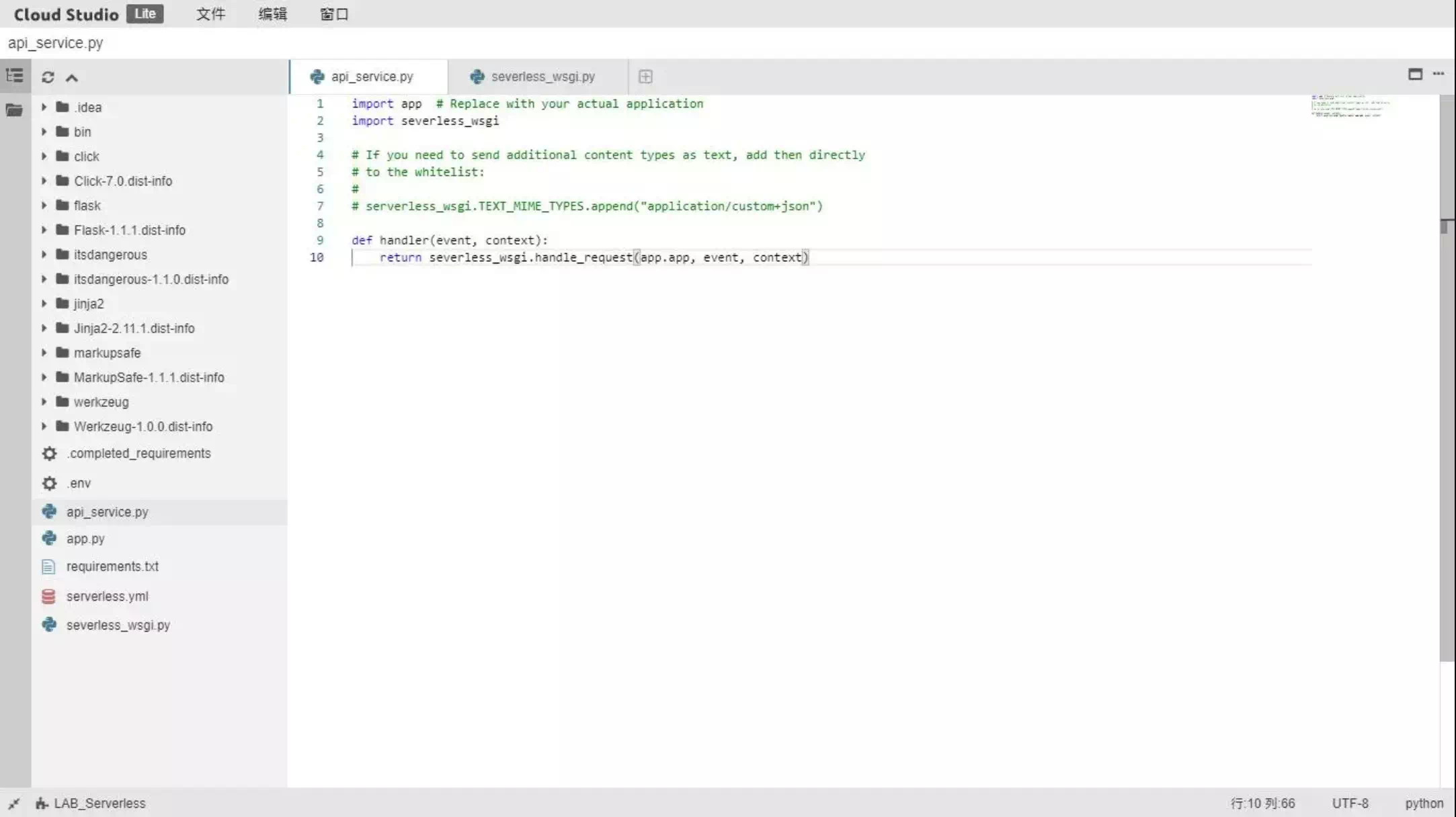
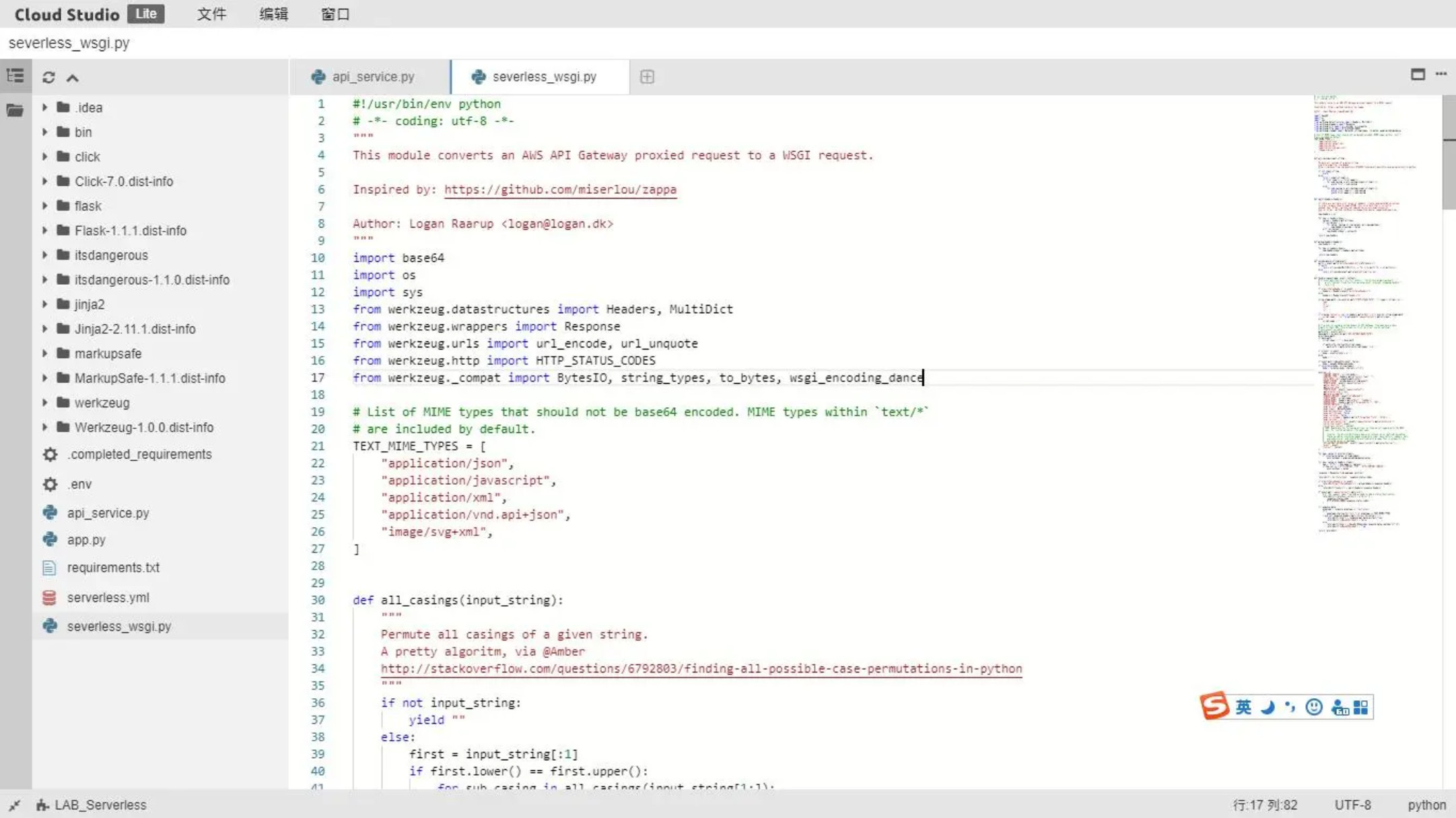
其實這就是Serverless的核心了,Serverless配置靜態頁面的原理自己是清楚的。比如Hexo就是生成頁面之后上傳到COS上就能訪問了。
但是,對于動態頁面就比較好奇了,這是怎么實現的呢?其實就是靠著serverless.wsgi 這個文件等等。能看到這個模塊描述:此模塊將 AWS APIGateway 代理請求轉換為 WSGI 請求。
""" This module converts an AWS API Gateway proxied request to a WSGI request. Inspired by: https://github.com/miserlou/zappa Author: Logan Raarup <logan@logan.dk> """
還是相當有意思的。
接下來就得一點兒一點兒進行遷移了,不難想到應該有非常多的坑的,比如如何訪問自己的 MySQL、Redis、 MongoDB,再比如Celery計劃任務,自己是用RabbitMQ 的消息隊列,這東西要怎么上云?
關于如何進行實驗室站遷移Serverless就分享到這里了,希望以上內容可以對大家有一定的幫助,可以學到更多知識。如果覺得文章不錯,可以把它分享出去讓更多的人看到。
免責聲明:本站發布的內容(圖片、視頻和文字)以原創、轉載和分享為主,文章觀點不代表本網站立場,如果涉及侵權請聯系站長郵箱:is@yisu.com進行舉報,并提供相關證據,一經查實,將立刻刪除涉嫌侵權內容。